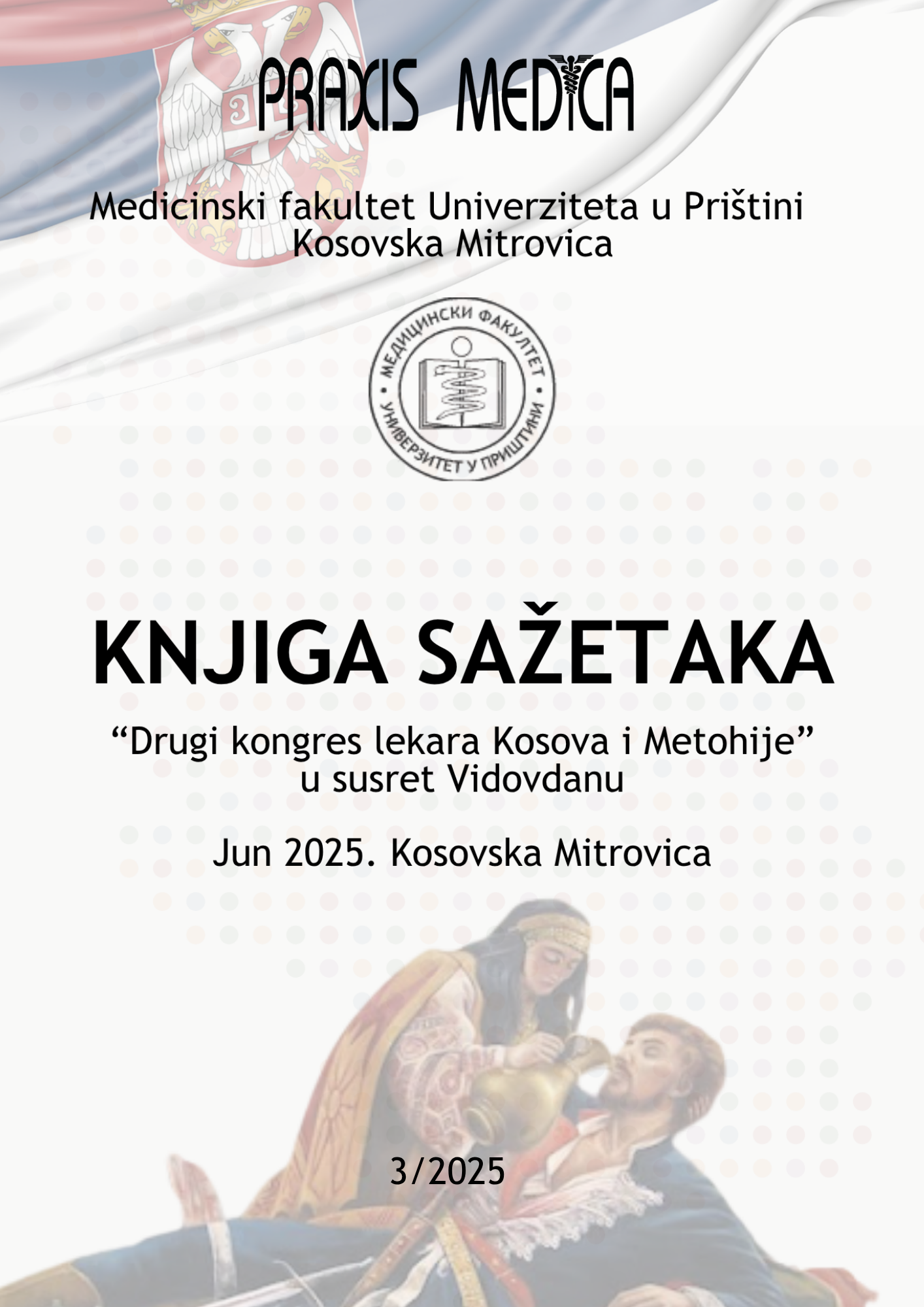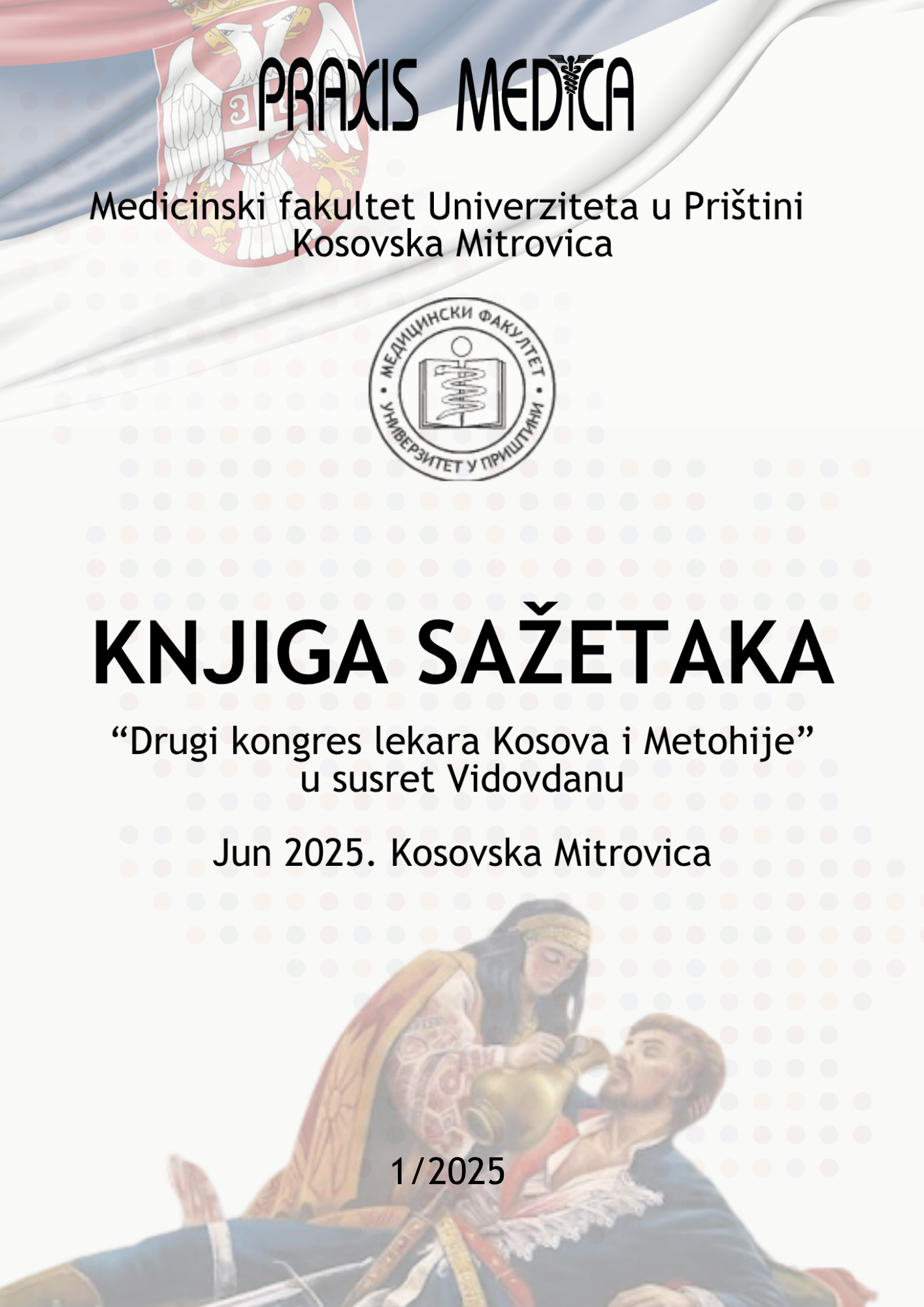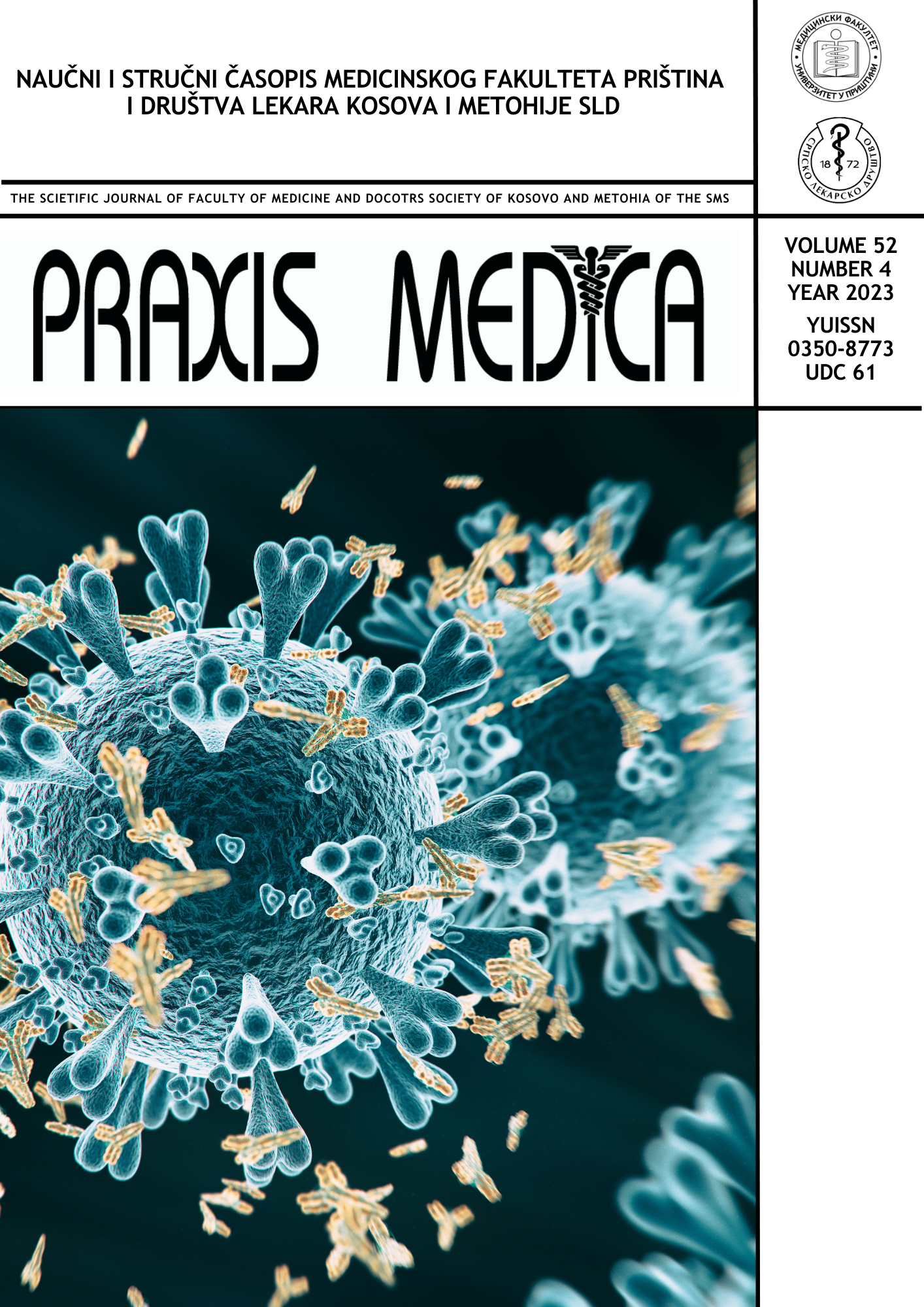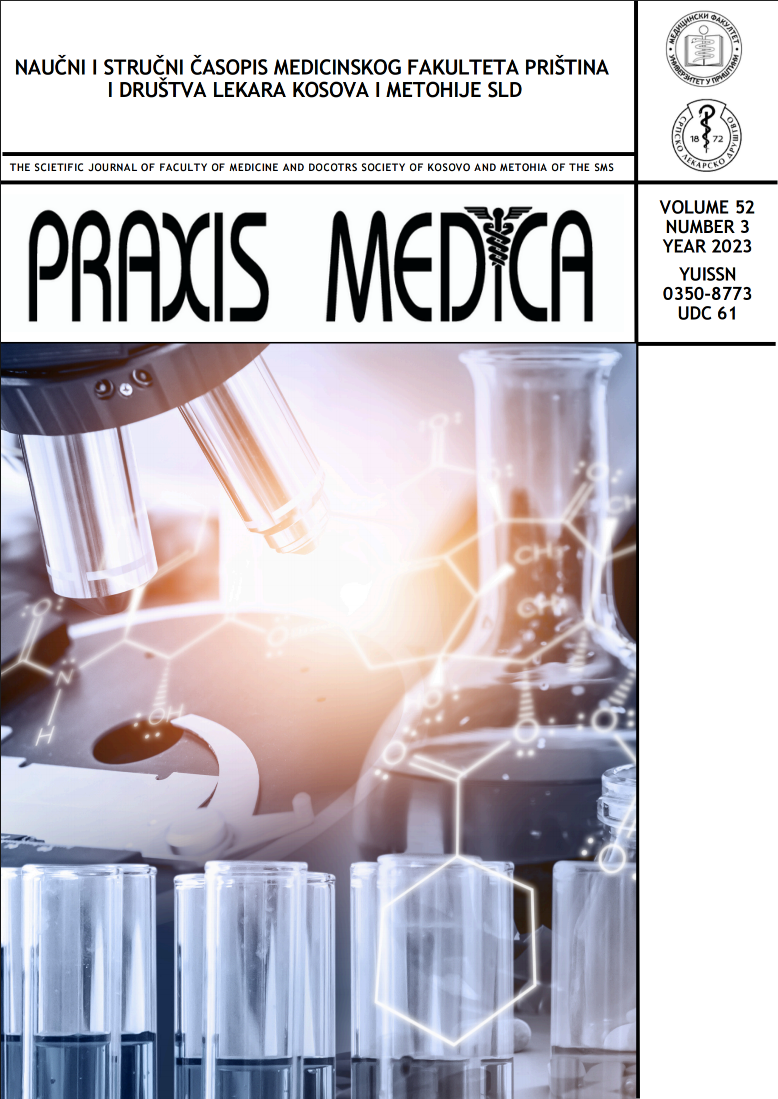Contents
01.12.2021.
Professional paper
Analysis of the characteristics of traffic trauma
Introduction: It is estimated that an average of 1,308 people die in traffic accidents in the world every day. Traffic accidents are caused by factors of the road, vehicles and the human factor, which occur alone or in combination with other factors in over 90% of cases. Material and methods: The retrospective systematic research included all cases of traffic trauma that were brought to the admission surgical outpatient clinic in the Clinical Hospital Center Kosovska Mitrovica in the period from January 2020 to December 2022. Results: In the observed period, 126 patients were registered. The age of the respondents differs statistically according to gender (p=0.030), and the highest frequency is male (81.8%) in the working population (18-59 years). The age of the subjects showed no statistical association with the types of injuries in traffic trauma (p=0.151). Friday and Saturday are the days with the highest risk (25.3% of injuries), and Sunday is the day with the least number of injuries (3.6%). The lowest number of injuries was recorded from January to May (n=12, 9.5%), and the highest was in the period August to October (n=54, 42.9%). A male patient, 20 years old, an alcoholic, required urgent surgical treatment (splenectomy) due to abdominal injuries. Alcoholism and the age of the subjects did not show statistical significance (p=0.495), and 24.6% of patients had a diagnosis of alcoholism. The age of the subjects showed a statistical association with hospitalization (p=0.004), male gender and age between 18-59 years. Only 2 patients required transport to a highly specialized facility. The fatal outcome showed a statistically significant correlation with the age of the respondent (p=0.016), there was only one patient (between 12-18 hours), a female, 85 years old as a passenger of a motor vehicle. Conclusion: The results of our study indicate a statistically significantly more frequent injury and hospitalization of male patients, that Friday and Saturday are the days of greatest risk and that the fatal outcome occurs in extremely elderly patients. Our findings favour the need to raise public awareness through the media, public actions and forums.
Mladen Kasalović, Aleksandar Jakovljević, Nikola Miljković, Gojko Igrutinović, Milica Milentijević, Aleksandra Milenković
01.12.2021.
Professional paper
Coronary sinus, microanatomical study
INTRODUCTION: Complete appreciation of the cardiac venous system requires an understanding of its embryological basis, its usual patterns of distribution, and its common variations. AIM: The aim of our study was to improve our understanding of the coronary sinus morphometrical and topographical anatomy. METHODS: The investigations were carried out on 25 human hearts (from 11 male and 14 female persons of mean age 59.5; range: 40 to 75 years). The classic anatomical technique of microdissection (using neurosurgical microinstruments) was performed under the stereoscopic microscope on 10 specimens injected with a 10% formaldehyde solution. The arteries and veins of an additional 15 hearts were injected with methylmethacrylate and immersed in a 40% solution of NaOH for corrosion. Following washing out and drying, the obtained vascular casts were examined and measured. RESULTS: Coronary sinus (CS) extends from the opening of the oblique vein of the left atrium into the great cardiac vein, to its empty orifice into the right atrium. The length of CS varied between 22.4 and 41.4 mm (mean 33.0 ± 6.1 mm). The diameter of CS at its beginning was 5.0 - 9.6 mm (mean 6.6 ± 1.3 mm), and its diameter at its atrial mouth varied from 6.6 - 12.0 mm (mean 8.4 ± 1.6 mm). The CS had varied relationships to the branches of the left or right coronary arteries. It extended superficial and above the artery in 16 (64%) hearts, and close superficial to the artery in 9 (36%) cases. Duplication of the superior vena cava associated with an aberrant left hepatic vein was found in one case. The persistent left superior vena cava, which drained into the right atrium via the enlarged coronary sinus, was formed by the persistence of the left anterior cardinal vein. CONCLUSION: Our study shows that the coronary sinus, created in an early stage of embryological development, is an important collecting vessel receiving the main veins of the heart.
Ema Bexheti, Emilija Novaković, Zdravko Vitošević, Milan Milisavljević
01.12.2021.
Professional paper
Prevention of micronutrient deficiencies in the elderly
The ageing process is characterized by numerous changes in the body that negatively affect the health, lifestyle and diet of the elderly. An adequate and balanced diet plays a vital role in the quality of life of the elderly, including physical, mental and social health. Physiological decline in food intake in the elderly is a risk factor for certain micronutrient deficiencies such as osteoporosis, anaemia and decreased immunity. To prevent these public health diseases, it is suggested to promote the intake of foods of animal origin (offal, meat) to prevent iron and vitamin B group deficiency. An adequate intake of anthocyanidins, fruits and vegetables with blue-purple pigments is recommended for the prevention of anaemia. Adequate intake is also important, i.e. intake of at least two portions of dairy products per day and fish products per week in combination with physical activity can provide adequate intake of calcium and vitamin D for the prevention of osteoporosis. The intake of fresh or minimally processed foods has played a significant role in ensuring an adequate intake of vitamin C, which, in addition to improving iron absorption and preventing anaemia, also affects the proper functioning of the immune system. For the same reason, it is recommended to take vitamin A from offals or beta-carotene from yellow-brown and orange fruits and vegetables. In general, appropriate nutritional interventions can be effective and financially effective forms of preventing and treating micronutrient deficits, thus improving the overall quality of life of the elderly
Dora Serenče, Hajnalka Požar
01.12.2020.
Professional paper
Effectiveness of coronavirus disease-19 vaccination on disease transmission, hospitalization, and clinical outcomes in adults in North India
Background: Covaxin and Covishield vaccines have rapidly rolled out in India to curb the pandemic. We aimed to test the hypothesis that COVID-19 vaccination is clinically effective. Methods: This study was conducted in the Department of Physiology at MGM College, Jaipur, India after approval from the Ethics Committee. Vaccinated and non-vaccinated groups were tested on disease transmission, hospitalization, and clinical outcomes. Researchers collected data using questionnaires circulated through google forms. The association between attributes was tested using the chi-squared test. The significance level was considered at 5%. Results: The vaccination significantly reduced disease transmission of COVID-19 [c2=4.51; p = 0.034]. However, no significant differences were seen in RTPCR positivity, chest CT findings, and hospitalization on vaccination. COVID-related symptoms and their severity were not statistically different between the two groups. Most elderly were vaccinated [c2=41.68; p < 0.001]. Most youths took one dose, while the elderly took two doses of the vaccine [c2=41.77; p < 0.001]. All age groups had similar severity of AEFIs [c2=13.22; p < 0.21]. The vaccination status across gender did not differ significantly. [c2=1.13; p < 0.288] Most males took two doses as compared to females [c2=6,57; p < 0.01]. Adverse effects post-immunization were more severe in females than males [c2=13.10; p < 0.001]. There was no association between the number of vaccine doses and the severity of AEFIs [c2=16.42; p = 0.06]. Conclusion: The present study concludes the beneficial effect of vaccination in reducing disease transmission. However, vaccination has no role in mitigating other COVID-related outcomes.
Kshitij Shah
01.12.2020.
Professional paper
The role of the electrocardiogram in identifying the risk of sudden cardiac death
Introduction: Sudden cardiac death (SCD) represents the unexpected and sudden death of young apparently healthy people. Alarge number of examined cases referred to professional athletes. There is not enough data in the literature related to those who performed sports in a sporadic and recreational manner. In order to prevent SCD, a screening protocol was determined, in which, an ECG performed at rest plays a important role. Based on the established criteria, changes on the ECG can be treated as normal, borderline and abnormal. An abnormal result indicates a risk of SCD. Objective: The aim of this study was to determine the risk of SCD in students who practice physical activity recreationally. Methods: The research involved 500 students (both sexes) of the 1st and 3rd year of study on the University of Pristina situated in Kosovska Mitrovica. As part of the regular systematic examination, an ECG was performed at rest. The risk of SCD was determined by analyzing the changes on the ECG and grouping them based on screening recommendations. Results: The obtained results show that 44% of students had changes on the ECG and that 8% of students had an abnormal result indicated a possible risk of sudden cardiac death. Conclusion: Therefore, timely recognizing and interpreting ECG changes in accordance with screening recommendations is an imperative for identification and possible prevention of SCD.
Biljana Zogović, Miljan Stašević, Ivan Radić
01.12.2020.
Professional paper
The impact of neuropsychological assessment in epileptic focus localization
Introduction: Epilepsy that takes place in the temporal lobe is manifested through three symptoms: aura, temporal pseudoabsence and automatisms, while right-sided temporal lobe epilepsy had been also linked with visual or image learning and memory deficits. Case outline: Patient 24 years old in 2020. In July 2020 had complex partial seizures with an unordinary psychomotoric reactions and verbalization, followed by qualitative conscience change in the form of confusion and amnesia. Therapy with paroxetine showed no result. Neuropsychological evaluation showed no other cognitive deficit than severe visuoconstruction dyspraxia and discrete decrease in complex attention. In behavioral aspect prodromal symptoms of tension, anxiety and depression were occurred. Conclusion: Neuropsychological assessment is, along the magnetic resonance imaging and electroencephalographic, the most important method for indicating cognitive deficit in epilepsy and determining the epileptic focus.
Marina Malobabić, Boban Biševac, Vesna Stokanović
01.12.2020.
Professional paper
Sensory processing disorders in premature infants
Introduction. Children born prematurely have an increased risk of immediate medical complications, as well as socioemotional, cognitive, linguistic and sensory processing disorders later in life. Studies have examined the effects of prematurity on developmental outcomes, such as cognition, however, there is a need for a more detailed examination of sensory processing disorders in preterm infants. Not only is prenatal neurosensory development interrupted in utero, but these children may also experience intense stimulation in the neonatal unit, which can further alter the development and function of the sensory system. Objective. The paper presents an overview of research on sensory processing disorders in premature infants, with special emphasis on the impact of the environment of the neonatal unit. Method. Insight into the relevant literature was performed by specialized search engines on the Internet and insight into the electronic database. Results. Sensory processing disorders affect 39% to 52% of newborns born prematurely, with some evidence to suggest that children born before 32 weeks are most at risk. The literature to date has consistently reported difficulties in sensory modulation of preterm infants, within the tactile, vestibular, auditory, oral, and visual domains. Conclusion. Sensory processing disorders in preterm infants appear to occur as a result of their immature neurological and biological system and being in the environment of a neonatal intensive care unit, which is unable to meet the sensory needs of preterm infants. Altered sensory experiences, during periods of neurodevelopmental vulnerability and fragility, can result in sensory processing disorders, which may include enhanced responses or less response to stimuli (hyper or hyposensitivity).
Jelena Todorović, Mirjana Petrović-Lazić
01.12.2020.
Professional paper
Prevalence, etiology and treatment of psychogenic aphonia in children: A case report
Introduction. Emotions are one of the most important psychological processes, with a decisive influence on a person's voice. Faced with the great challenges and changes that primary and secondary socialization agents impose in the process of growing up, children consequently experience a spectrum of various unpleasant feelings: anxiety, fear, anger, frustration and sadness. Due to the fast-paced lifestyle, it often happens that the child ignores unpleasant feelings, which further worsens the condition in which he finds himself. Among other conditions, psychogenic aphonia in children has become more frequent in recent years. The current case report aims to determine the frequency of psychogenic aphonia in children, to identify the most common causes that lead to psychogenic aphonia and highlight the methods of vocal treatment that give the best results during rehabilitation. Case report. The current paper presents the results collected in a two-year period at the Clinic for Ear, Throat and Nose of the Clinical Hospital Center "Zvezdara". In the period from March 2017 to May 2019, psychogenic aphonia was diagnosed in 31 patients, which is an evident increase compared to the previous ten-year period in which psychogenic aphonia was diagnosed in 38 younger patients. Analyzing heteroanamnestic data obtained from parents, the most common answer about the cause of psychogenic aphonia is dissatisfaction with school success. After successful diagnostics by an otorhinolaryngologist, psychiatrist and vocal pathologist, in the process of rehabilitation of psychogenic aphonia, methods of digital manipulation of the larynx, methods of restoring the voice with cough reflex and methods of turning out the feedback system were applied. In this particular case, the method of digital manipulation of the larynx gave the best results. Conclusion. Optimal evaluation of patients with voice disorders requires the joint efforts of experts from different disciplines. Having in mind the tendency of recurrence of psychogenic aphonia, these findings suggest that the integration of the interventions of a vocal pathologist and a psychiatrist could give effective results in the process of rehabilitation voice.
Mirjana Petrović-Lazić, Ivana Ilić-Savić
01.12.2020.
Professional paper
Treatment fracture of the diaphisis humerus with functional plaster
Treatment of humerus fractures is divided into operative and non-operative treatment Fractures of the diaphysis of the humerus heal well. Surgeons today have many opportunities to treat them. The decision on the type of treatment to be applied depends on the location of the fracture, the existence of associated injuries, the age and the general condition of the patient. Non-operative treatment is most often applied, although there are fractures in which surgical intervention is necessary in order to perform healing and prevent complications. Non-operative treatment of fractures of the diaphysis of the humerus gives good results, with little angulation and minimal or no shortening of the arm. Adequate repositioning, appropriate plaster immobilization and regular X-rays heal the fracture within the allotted time. Disciplined early physical therapy in terms of circular movements prevents shoulder contracture and allows later physical therapy to last significantly shorter. Non-operative treatment lasts from 7-11,5 weeks.
Saša Jovanović, N. Miljković, D. Petrović, Lj. Jakšić, G. Radojević, A. Božović
01.12.2020.
Professional paper
The effects of exertional heat stress on some complex cognitive functions
Introduction/Aim: Heat stress represents the important problem in military services. This study investigates the effects of exertional heat stress on complex cognitive functions. Methods: 40 male soldiers performed exertional heat stress test, of which 10 performed the test of the same intensity in cool environment. Cognitive functions were mesured by computerized battery CANTAB, before and immediately after exertional heat stress test. Results: Exertional heat stress led to impairment of some cognitive functions in unacclimatized group: decrease of accuracy in MTS test (from 92,6±4,2% towards 84,5±6,9%, p<0,05) and PSRs (from 85,0±8,0% towards 77,0±9,6%, p<0,05), while similar decreases were recorded in MTS test in passively acclimatized group (from 92,2±5,5% towards 87,7±5,6%, p<0,05) i.e. in PSRs test in actively acclimatized group (from 83,3±6,3% towards 69,4±5,1%, p<0,05). The reaction time was not affected in any group whatsoever. Discussion and conclusion: Exertional heat stress leads to mild impairment of complex cognitive functions, particularly in domain of accuracy. Physical strain itself, however, does not affect cognitive functions. Relatively resistance to heat stress in zoung soldiers may be contributed to their high aerobic level.
Jelena Stojićević, Vanja Jovanović












